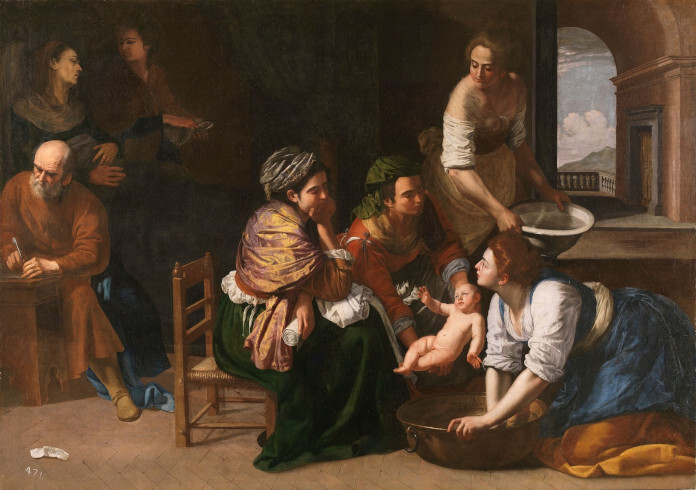Advertisements
[ad_1]
In the 17th century it was highly celebrated and valued in Europe. He worked for the kings of England and Spain, for the viceroy of Naples, for important patrons of the time and became a phenomenon. Artemisia Gentileschi (Rome, 1593 – Naples, 1653) found a way to express herself, to make herself heard in a world and time strongly dominated by men, and had a completely autonomous life thanks to her enormous talent and intelligent connections. However, for centuries her figure was forgotten until in the 20th century feminist currents rescued her to give her back the value and place she deserves in the History of Art. Now, as part of this recovery, The National Gallery in London dedicates a major retrospective to the Baroque painter that shows us the artist with all her rough edges.
The germ of this exhibition dates back to 2018, when the art gallery led by Gabriele Finaldi acquired Self-portrait as Saint Catherine of Alexandria (1615–17)“the first painting by the artist to enter a public collection in the United Kingdom”, recalls the director. With this objective, the inauguration was scheduled for April, but the coronavirus gained strength and, like everything else, it had to be postponed. Finally, it opens this Saturday, October 3rd and can be seen until January 24th. In addition to his paintings, This exhibition features documents such as recently discovered letters and the transcript of the rape trial that took place in Rome.
Artemisia, a young woman in the shadow
Artemisia Gentileschi was the eldest (and only female) daughter of fellow painter Orazio Gentileschi. “Growing up was not easy for her, her mother died when she was 12 years old, she grew up in a male-dominated family environment and the care of her three younger brothers fell on her,” explains Letizia Treves, curator of the exhibition. From a young age, she showed talent and her father educated her in the art of painting like her brothers. However, hers was different because she was a single woman who “could not walk freely through the city streets copying works like her brothers”. So she had to stay at home and, in her words, it was harmful, a torment.

“We know that he was painting independently at the age of 16. His first signed and dated work was made at the age of 17 and looking closely you can see how mature and sophisticated his brushwork is”, observes Treves. At that age he had already assimilated the technique that his father had taught him. What was the first work we knew of her? It's about Susana and the old woman, a well-known passage from the Old Testament in which Susana is raped by two men. At this moment, Artemisia “brings a feminine perspective to the story”, and focuses on the situation that this vulnerable woman lives, getting under her skin and giving us goosebumps.
Of course, she didn't know that just a few months later she herself would suffer a similar episode when was raped by the painter Agostino Tassi at his father's house. The young woman began a several-month relationship with him with the “false hope that he would marry her, but when she saw that this would never happen, her father Orazio filed a complaint,” says Treves. The trial lasted several difficult months, during which Artemisia continued to paint, although “not many paintings from this period exist.” All details of the court process are collected in a bookopened by the page in which some of the tortures to which the artist was subjected are narrated, which is presented to the public for the first time.
Verdict and transfer to Florence
In November 1612, Tassi was found guilty and had to choose between exile and five years of hard labor. Although he opted for the first option, it never happened and only one day after the verdict. married artemisia with the little brother of the notary who led his defense. With him decided to move to Florence, the city where a new phase for the artist began. Although this dramatic episode sometimes overshadows her talent, the truth is that Artemisia was one of the most talented artists of her time, something that can be seen in her Florentine period.
There he learned to read and write and she enrolled at art school in 1616, becoming the first woman to be accepted. Thanks to this, he was able to meet contemporary artists and was introduced to the city's artistic circles, a circumstance that opened the door for him to meet great patrons such as the Medici. However, it was in Florence that he created his best-known work of art. This period is represented in the rooms of the National Gallery with the presence of the two versions that Artemisia made Judith beheading Holofernes. In them “we see the artist painting another well-known theme from the Bible. Artemisia dives straight into the protagonist's skin and imagines the scene. The way the blood spreads is very realistic”, says Letizia Treves. However, the artist does not sign with her usual surname, but rather with her paternal grandfather's surname, Lomi, “a very good strategy to make them feel more like a compatriot”.
On many occasions it has been said that Artemisia Gentileschi's works are autobiographical and it is that during the Florentine phase she began to include herself in her works and makes many self-portraits in which she adopts different roles. However, there was a setback in her life, as in addition to having five children in five years, her husband had debts that kept them in constant economic difficulty. Artemisia was the family's breadwinner and when in 1620 the situation became untenable they decided to return to Rome.
a star in rome
“During the seven years that she was away from Rome she became an artist with considerable success and when she returned, her patrons not only wanted her works but also commissioned portraits of her, became the object of other artists such as Dumonstier or Simon Vouet”, details the exhibition curator. Shortly after her return, her father left the city and in 1623 she separated from her husband, continuing with a case started in Naples and of which we know through correspondence, discovered in 2011, which is displayed in a shop window.
Completely removed from her father's shadow and free from marriage in the 1620s became the best period of his artistic career. Although the circle of friends he gathered during the years he was in Rome is unknown, what is noticeable is a change in his painting. At a time when “There was a fever for collecting works in the style caravaggio his works become more naturalistic and take on the painter’s dramatic light.”says Treves. We see, therefore, that Artemisia adapts to the tastes of each era and adopts the corresponding characteristics in her painting. “Although she continued to paint women from the Bible and ancient history, what she brought to the table was a feminine sensibility that collectors could appreciate. That was his best asset”, says the curator.
25 years in Naples
At the end of 1620, he made a brief trip to Venice, but the plague that ravaged the city affected his transfer to Naples in the summer of 1630. There he once again adapted to the tastes of the time and society, creating large altarpieces on which he was able to collaborate with other artists. Not counting the trip she took to London, which lasted around two years, the painter remained in the southern Italian city until the end of her life. Although it can be read in his letters that he did not like this city because he considered it violent and expensive, it was there that “he expanded his repertoire to include allegories and literary themes”. The tour of the National Gallery ends as it begins, with another version of the Susana and the old woman discovered in 2008. Although the one that begins the exhibition is the first known, this is the last signed and dated that there is evidence. “If the two pieces were not signed and dated, it would be very difficult to determine whether they are his”, points out Letizia Treves.
In recent years, new paintings by the great Baroque painter have been discovered, so Treves does not rule out more being found little by little. In short, this great retrospective shows us a stubborn and determined Artemisia who charted a path for herself in painting. But no one better than her to define herself as she did in a letter she sent to Antonio Ruffo in 1649: “with me, your honor, you will not lose, and you will find the spirit of Caesar in the soul of a woman. “



